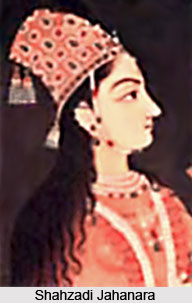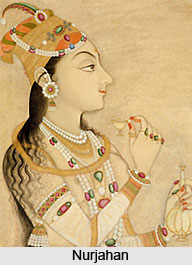 Imperial treasury of Aurangzeb was a most impressive collection of wealth and a display of immense grandeur. An account of the immense wealth of the Mughals has been available from the accounts of the French jeweller and traveller Tavernier. He was one of the few foreigners to be granted the singular honour of viewing part of the treasure of the Mughals and he left a detailed description of the display. On 2 November 1661, Aqil Reza opened the doors of the vault to the merchant, and a most ceremonious presentation followed. Four eunuchs laid out two large wooden trays lacquered with gold leaf and covered with little carpets especially made for this purpose, one of red and the other of green embroidered velvet, in front of three scribes who counted and recorded in turn. Tavernier`s experienced eye enumerated thousands of gems, which could have paid a king`s ransom many times over.
Imperial treasury of Aurangzeb was a most impressive collection of wealth and a display of immense grandeur. An account of the immense wealth of the Mughals has been available from the accounts of the French jeweller and traveller Tavernier. He was one of the few foreigners to be granted the singular honour of viewing part of the treasure of the Mughals and he left a detailed description of the display. On 2 November 1661, Aqil Reza opened the doors of the vault to the merchant, and a most ceremonious presentation followed. Four eunuchs laid out two large wooden trays lacquered with gold leaf and covered with little carpets especially made for this purpose, one of red and the other of green embroidered velvet, in front of three scribes who counted and recorded in turn. Tavernier`s experienced eye enumerated thousands of gems, which could have paid a king`s ransom many times over.
Pearls in the Imperial Treasury of Aurangzeb
Amongst the breathtaking, glittering array was an enormous pearl which Shahzadi Jahanara Begum Sahib had given her father during one of his weighing-ins. There was another huge round pearl that shone like a mirror, which Shah Abbas II had given to Aurangzeb. It was comparable in purity and size to another pearl that Aurangzeb had bought for its beauty, which he often wore around his neck, alternating it with his famous topaz. There was a frame of pearls that hung around the portrait of Aurangzeb`s grandfather Jahangir, and even the cord from which it hung was made of these jewels. In the picture, he wore on his turban a brooch of pearls held by another pearl of 47 ratis. Jahangir is known to have been very fond of pearls and He himself had gifted his most faithful servants a lot of these jewels. It seems that Shah Jahan inherited the preference for the fruit of the oyster. He had a band of 130 pearls wrapped around Jahanara`s arm to celebrate her recovery in 1644. Aurangzeb was also presented with a fantastic necklace of 280 pearls by Mir Jumla`s son Muhammad Amin Khan. However, probably the most beautiful pearl of the Mughals was the one with a yellowish shine embedded in the head of the peacock of the famous Peacock Throne.
Emeralds in the Imperial Treasury of Aurangzeb
In the Treasury there were several prominent emeralds. One was an exceptionally large stone of 217 carats from Columbia. On one side it was engraved with flowers and foliage, on the other was a verse from The Holy Quran. There was a more modest emerald, of 78 carats and on one surface were inscribed the words, `He who possesses this talisman enjoys God`s protection.` It was believed that all sorts of human faults, fears and desires could be addressed by these amulets, such as fear of blindness, invisible enemies, and requited love, since green is the colour of Venus. However, since green was also the favourite colour of the Holy Prophet Muhammad of Islam, emeralds were much sought after for their mysterious powers by the Mughal court. The purest of these was Akbar`s emerald, a stone of 426 Ratis, and Jahangir had two famous emeralds gifted to him, one by Abdul Khan and the other by the Raja of Burma, and, of course, there was the large prominent emerald of the Peacock Throne.
Diamonds in the Imperial Treasury of Aurangzeb
Engraving is much more difficult on diamonds than on emeralds, but sometimes royalty would have their names engraved on special diamonds to show their ownership. One 88 carat diamond, bearing the name of Shah Jahan, son of Jahangir, was suspended by a golden cord in front of the Peacock Throne. It was taken away by Nadir Shah and subsequently engraved with the name of his Persian successor. Mir Jumla offered his best diamonds to the Emperor Shah Jahan in order to gain favour at court. The largest diamond he possessed was said to be the size of an egg and was a rose-cut. It had been excavated from the famous Kolour mine near Golconda, which Tavernier claims was worked by 600,000 labourers. A miniature depicts this fabulous jewel surrounded by jagged blue rocks guarded by serpents, eagles fly above holding pieces of diamond-studded meat in their talons.
 Among the treasure there were also `red diamonds`. They too were shown to the French jeweller, glittering translucent pebbles looking like blobs of coagulated blood. The name belies their worth. They are not diamonds, they are a type of ruby, in fact of poorer quality since they are actually a variety of spinel. Red diamonds are said to have a blood-red colour and are also known as Oriental Corundum. They are usually found in the mines of Badakhshan, a province of Afghanistan. One such jewel of better quality and size was used to adorn the Peacock Throne and was later set in the Persian tiara. Another huge spinel is known as the `Taimur Ruby` and is now in the British crown jewels. It was said to have been looted by Tamerlane when he sacked Delhi in 1398. He took it away hidden in his furs. It has part of the Mughal genealogy engraved on it, starting from the Emperor Jahangir. There are a total of six names, the last being Ahmed Shah Durrani, who was not a Mughal. After Timur, it fell into the hands of Shah Abbas I of Persia, who in 1610 presented it to Jahangir as a `world tribute`, and thus the jewel returned to the dynasty. The emperor immediately had his own name engraved on it along with the Hijri date of 1021, and Akbar`s name. Subsequently Shah Jahan and Aurangzeb did likewise.
Among the treasure there were also `red diamonds`. They too were shown to the French jeweller, glittering translucent pebbles looking like blobs of coagulated blood. The name belies their worth. They are not diamonds, they are a type of ruby, in fact of poorer quality since they are actually a variety of spinel. Red diamonds are said to have a blood-red colour and are also known as Oriental Corundum. They are usually found in the mines of Badakhshan, a province of Afghanistan. One such jewel of better quality and size was used to adorn the Peacock Throne and was later set in the Persian tiara. Another huge spinel is known as the `Taimur Ruby` and is now in the British crown jewels. It was said to have been looted by Tamerlane when he sacked Delhi in 1398. He took it away hidden in his furs. It has part of the Mughal genealogy engraved on it, starting from the Emperor Jahangir. There are a total of six names, the last being Ahmed Shah Durrani, who was not a Mughal. After Timur, it fell into the hands of Shah Abbas I of Persia, who in 1610 presented it to Jahangir as a `world tribute`, and thus the jewel returned to the dynasty. The emperor immediately had his own name engraved on it along with the Hijri date of 1021, and Akbar`s name. Subsequently Shah Jahan and Aurangzeb did likewise.
Proper and more precious corundums were among the collection as well. Akbar owned one weighing 284 ratis, his son Danyal gave him a second one weighing 104 ratis, and a third was presented by a Raja.
Rubies in the Imperial Treasury of Aurangzeb
Jahangir owned two rubies, respectively weighing 300 and 168 ratis, gifted by Asaf Jah, Nur Jahan`s elder brother and father of Mumtaz Mahal. In return, the emperor gave his brother-in-law a sword called `the rower of heads`. Zamana Beg known as Mahabat Khan, famous for having killed a Rajput Raja on Jahangir`s orders, offered the emperor a ruby of 300 ratis, and Prince Khurram gave his father one weighing 192 ratis which he had received as a gift from Raja Man Singh of Udaipur. In return, Jahangir gave the prince two rubies from the rich Mogok mines in Burma. One weighed 312 ratis and was engraved. It is believed that it must have been imperfect and engraved to cover the defect.
Jahangir was so fond of rubies that he wore five of them on his turban, the largest was 288 ratis. Aurangzeb did not care as much for them, though he is known to have accepted one weighing 125 ratis with pleasure.
Sapphires in the Imperial Treasury of Aurangzeb
If the emperor had any preference among jewels, it was for sapphires. Among the few purchases he made was a rare yellow sapphire bought in Goa. It weighed more than 112 ratis and must have come from the mines of Ratnapura in Ceylon. In the traditional lore of the empirical properties of jewels, the sapphire was considered `the gemstone of kings par Excellence, gave good counsel to the wearer, always on condition of clarity, purity, and without any stain`. In the collection that Tavernier saw, there were comparatively very few sapphires. One that must have caught his jeweller`s eye was a beautiful one with purplish-blue reflections weighing 40 ratis. This jewel is depicted in a miniature of the Emperor dated 1670. It hangs on his chest on a plain strand of pearls, half hidden by his hand, which is holding a violet iris matching his floral brocade Jama. The red and blue brocade turban is entwined with mauve gauze, its folds clasped by a brooch with a purple ruby flanked by two pearls. Bluish feathers rise from the Sarpeh. The emperor wears a sumptuous cloak of old-gold brocade, embroidered with little red and yellow flowers and lined with sable. The whole painting is a deliberate harmony in pale purple, suggesting the royal pride of the imperious figure in kingly dress transposed into melancholic patience. Violet hues are also symbolic of the amethyst, which represents religious zeal and philosophy, preserving the soul from drunkenness and passions. Even the choice of the sapphire and iris are suggestive in this regard.
Thus described above was the imperial treasury during the time of Aurangzeb- resplendent in the transparent fire of diamonds, the orange and blue flames of sapphires, the burning glow of yellow topazes, the radiance of rubies, and the flash of star sapphires.






































